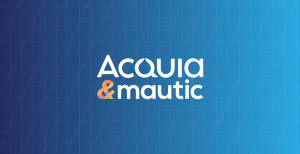
Acquia Acquires Mautic: Q&A with Founders Dries Buytaert and DB Hurley

Today, Acquia announced the acquisition of Mautic, Inc., the world’s first open source marketing automation and campaign management platform. The addition of Mautic will bolster Acquia’s Open Digital Experience Platform, offering customers new opportunities to automate, personalize, and measure the entire customer lifecycle – across every channel, at every stage, and at every interaction.
If you’re not familiar with Mautic, it’s an alternative to Adobe's Marketo or Salesforce's Marketing Cloud. However, Mautic is better because it’s an open and flexible platform built on open source code, and it’s much simpler to use. With Mautic, organizations can orchestrate seamless, one-to-one customer experiences across any digital channel, such as the web, email, SMS, push notifications, social media, or emerging channels like voice. Mautic’s platform allows for open innovation and thousands of integrations, making it easy for marketing teams to combine the tools of their choice, instead of experiencing vendor lockin. We sat down with the founders of both companies — Dries Buytaert of Acquia and DB Hurley of Mautic — to talk about the acquisition, and how modern marketing teams are using technology to improve the customer experience.
Q: Tell us a little more about Mautic.
DB: Mautic is a type of marketing automation platform that’s never been seen before. We set out to give marketers a way to create simple or complex campaigns with the ease of dragging and dropping items onto a page. And, we wanted to provide a way to customize the customer journey depending on the customer’s preferred digital channel -- whether it’s on the web, email, SMS, push notifications, social media, or emerging channels like voice. While these ideas may sound simple, they’ve been accomplished with the power of an open source community behind them.
Q: Why is the acquisition of Mautic important?
Dries: A few decades ago, I believed everyone needed a website. Now, websites are table stakes. Today, I believe everyone needs a Digital Experience Platform. Users aren’t just interacting with brands through their websites anymore. By adding Mautic’s marketing automation and campaign management technology to Acquia’s Open Digital Experience Platform, we can help marketers reach customers on their preferred channel, in ways that are personal and relevant to them.
Q: Why did you decide to sell your company now?
DB: It's a good question, because Mautic had a fantastic year where our top-line grew almost 4X year-over-year, our number of customers tripled, and we won multiple awards for product innovation and customer ROI. While we could continue to grow at our own pace, we believe our open solution is superior and belongs in every marketer's hands. Joining with Acquia accelerates that mission, and puts both companies in a position of strength relative to incumbents in the market.
Dries: The opportunity was too big to ignore. Together, our companies create the only Open Digital Experience Platform, which provides both marketers and developers with unprecedented flexibility and freedom.
DB: Beyond the market opportunity, our companies have a great cultural fit. Acquia and Mautic both support our respective open source communities and share similar values when it comes to giving back. Acquia will continue to invest in Mautic, where I will remain as project lead and continue to grow the community.
Q: How are Drupal’s and Mautic’s open source communities similar?
Dries: Our communities are very complementary, both from a technology and culture perspective. Both are built on PHP and Symfony, and use the GPL license. These similarities benefit everyone — customers, partners and contributors -- by making it much easier to collaborate. For example, if you are already doing Drupal development, Mautic doesn’t require a different set of skills. I’ve known DB for a long time, and am impressed with the community he’s built. Culturally it shares a lot of the same values as Drupal, with a globally distributed group of talented developers that are all committed to supporting each other and writing the best code.
Q: What are some of the latest trends in marketing automation?
Dries: According to Forrester, global marketing automation spend will surpass $25 billion by 2023. More than half of global marketers are planning to increase their spend on marketing technology within the next year. Marketers are looking for platforms that will help them deliver personalized content across the entire digital experience. Customers expect brands to know them on a personal level, but many marketers are learning that legacy marketing clouds are falling short. That’s why we’re excited to join with Mautic; Acquia’s Open Marketing Cloud will make it much simpler to automate and personalize marketing campaigns across any digital channel.
Q: How does Mautic compare to Marketo?
DB: Mautic often beats other legacy marketing automation vendors on simplicity and ease of use. Compared to Mautic, solutions like Marketo have a steep learning curve. As a few examples, Mautic's visual campaign builder is clean and simple to use. To contrast, Marketo's email and landing page builder is severely limited, and requires a graphic designer and front-end developer to customize. Another advantage is Mautic’s open architecture. While Marketo limits customers to one website domain per Marketo instance, a single instance of Mautic can sit on top of one domain, 10, or 100.
Mautic also supports cross-channel communications like SMS or mobile alerts out of the box, which many legacy vendors do not. Mautic was built with the modern customer journey in mind, as customers often weave their way in and out of different channels like websites, email, SMS, mobile apps and more.
Q: If Mautic is open source, why would someone pay for it?
DB: Mautic Cloud Pro is a fully managed SaaS solution. In other words, customers sign up for a subscription and never have to worry about the management and maintenance of the software -- that's all handled by Mautic, Inc. Integral to that cloud offering, we have optimized our hosting environment specifically for Mautic. We've added dozens of enhancements to ensure high performance and scalability for all sizes of databases, we have improved email delivery by 100x, and we partner with best-of-breed delivery partners while still giving customers the freedom to bring their own provider. We've also built several enterprise-grade features atop the open source core code that enable customers to easily solve their biggest challenges with Mautic Cloud Pro. For example, we've also extended the Mautic Platform by adding Maestro to help enterprises manage multiple instances of Mautic marketing automation. Maestro offers the capability to analyze campaigns across those individual accounts, and enables users to quickly clone successful campaigns and reuse best practices.
Check out our demo or sandbox environment to learn more.
Q: Why is open source important in the marketing tech stack?
Dries: It comes down to a few things. First, proprietary vendors are focused on their own products, rather than integrating with outside technologies. The best and fastest way to innovate is by integrating Open Source software with best-in-class technologies. With thousands of options to choose from in the martech landscape, marketers and developers don’t want to be locked in to a single suite. They want the freedom and flexibility to use the best tools for the job. Also, Open Source software has faster innovation cycles, is easier to try and is less expensive than proprietary software.
All of these things are especially important in an area like marketing, where there is so much data, and so many disparate systems to connect. Ultimately, marketers want to keep up with their customers and that means taking advantage of the latest and greatest technologies, or the technologies that make the most sense for their industry or customers.
Q: How is the relationship between marketers and developers changing?
Dries: In the past, developers didn’t have much of a voice in marketing. Today, everything has changed. Developers are the architects of modern digital marketing -- they’re responsible for building and customizing digital experience platforms. Unlike most of our competitors, we've always cared deeply about developers. It's deep in our DNA. The same is true for Mautic, so the Mautic acquisition builds on that strength. Smart marketers know that developers are an equal partner in building amazing customer experiences. I'm convinced that will become more and more important in the years ahead.
Q: What makes you excited about the future?
DB: I can’t imagine a better place for Mautic to continue to deliver on the promise of open marketing. Our two companies believe in the same vision of an Open Digital Experience Platform. Together we’ll continue to help marketers and developers build the digital experiences they want — on their own terms. As new technologies such as voice, connected devices, and machine learning emerge, our open source approach will bring the latest capabilities to marketers faster. All of this, of course, is built to serve customers with relevant and personal experiences, and ultimately make the web a better place.
You can read more about the acquisition in our FAQ, or learn more about Acquia’s Open Digital Experience Platform.
